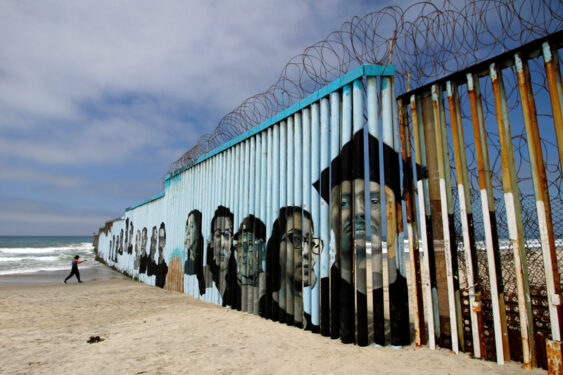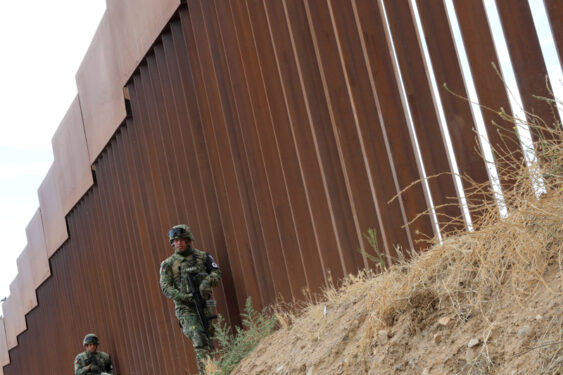NEW YORK — In Tijuana, on the Mexico side of the U.S.-Mexico border, Father Pat Murphy assesses at least 2,000 migrants camping on a cement pavilion outside of an immigration facility. His migration shelter is full, and even more people are living on the streets.

Father Murphy and other immigration advocates now fear Mexico border cities will become even more overwhelmed after the Supreme Court on Aug. 24 upheld a lower court ruling ordering the Biden administration to reinstate a Trump administration policy that forces asylum seekers to stay in Mexico until their case is decided.
“I just don’t know where they’re going to put all of the people,” said Father Murphy, director of Casa del Migrante, a non-profit group that assists migrants.
“The shelter space certainly has not expanded. A lot of people are living on the streets. A lot are living in unsafe situations. The only ones that are going to gain are the smugglers who’ll look for new ways to get people across,” the priest told The Tablet.
The high court’s 6-3 ruling halted President Joe Biden’s effort to rescind the Remain in Mexico policy, formally known as the Migration Protection Protocols program. The court issued only a brief explanation, writing in an unsigned order that the administration “had failed to show a likelihood of success on the claim that the memorandum rescinding the Migrant Protection Protocols was not arbitrary and capricious.”
Biden suspended the program, created by President Donald Trump in 2019, on his first day in office. The U.S. Department of Homeland Security ended the program in June. U.S. District Judge Matthew Kacsmaryk in Amarillo then ordered that the program be reinstated in a decision from a lawsuit filed by the states of Texas and Missouri, which is what the Supreme Court upheld.
Catholic immigration leaders, many of whom have experienced the effects of the policy firsthand, were shocked, saddened and angered by the ruling.
“With this pronouncement, the situation will be worse,” Archbishop Gustavo García-Siller of San Antonio told The Tablet. “This is not for the better of the people. It’s not for the better of a country dealing with international law and the fact that migration is global, we are not showing leadership in that area. It’s very tragic.”
Archbishop John Wester of Santa Fe said the policy “flies in the face” of international and domestic law because people have a right to asylum. He doesn’t understand how the government can willingly put migrants in danger.

“From my point of view as a pastor what bothers me most is that this policy places people in immediate danger,” Archbishop Wester told The Tablet. “The Remain in Mexico policy is very dangerous to these people so not only are they not getting their cases heard here as they should, by law, but they’re being forced into a terrible situation.”
Dylan Corbett, executive director of Hope Border Institute in El Paso, remembers watching migrants he worked with in Ciudad Juárez die in the hospital because of the lack of healthcare that existed across the border after the policy was enacted. He said the organization buried others, and saw children go without education for months on end.
“These [Mexico-side] border communities simply do not have the capacity to receive humanely and with dignity a mass number of asylum seekers,” Corbett told The Tablet. “They lack basic infrastructure, shelter, land, and the ability to meet the unique needs of families.”
Joanna Williams, executive director of the Kino Border Initiative that operates in Nogales in Arizona and Mexico, says the program created confusion and drastically increased the number of people they aided.
She also said U.S authorities committed abuses through the process, including a lack of language interpretation, family separation, misinformation, verbal abuse, and at least one documented case of sexual assault.
“The end of the program was not arbitrary and capricious as the judges have said, but it was in fact very well-reasoned and based on the evidence that ourselves and other groups put forward in these complaints,” Williams told The Tablet.
It’s still unclear when and how the Biden administration will re-implement the program. The Trump administration largely stopped using it at the start of the pandemic.
The ruling also doesn’t prevent the Biden administration from trying to end the program again. Homeland Security has already indicated it plans to do so, writing in a statement after the ruling that it “regrets that the Supreme Court declined to issue a stay,” and will continue to “vigorously challenge” the district court’s order.
The immigration advocates that spoke with The Tablet said they understand that the Biden administration couldn’t control the Supreme Court’s decision, however, they put the onus on the Biden administration for keeping in place Title 42 — a Trump-era policy that allows U.S. authorities to expel migrants on the grounds of public health, limiting their legal right to seek asylum – and not fixing the asylum process.
“The administration needs to remedy this,” Corbett said. “The president needs to marshal a strong convincing argument about asylum at the border, and he needs to make it happen. That includes rolling back Title 42 and that includes rolling back Remain in Mexico the right way.”
Father Murphy explained the reason more and more people are crossing the border is because they don’t see any legal way to take care of their situations. He said he answers 15-20 Facebook messages a day where people ask how they can apply for political asylum, to which he answers, “the process is closed and we have no idea when it’s going to open.’”
“People are desperate, and the government has not shown any will to reopen the asylum process, which is an international right. You probably can’t open it in a way it should be open, but at least give us some kind of hope that you have a plan in mind,” Father Murphy said.
He added that because the Remain in Mexico policy is a bilateral agreement, the Mexican government should just refuse to take migrants from the program; however, he said he doesn’t think “Mexico would have the guts to do that.”
García-Siller noted that regardless of what happens at the government level the Church will continue its advocacy on behalf of the migrants.
“We are not going to stop providing for the people in need,” García-Siller said. “We will take this opportunity to bring about more conscience in people’s lives about the reality of the migrants and a conversion needs to take place in people’s hearts and minds.”
Follow John Lavenburg on Twitter: @johnlavenburg
